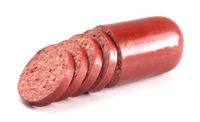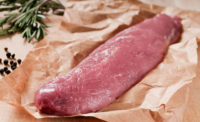Foodborne illness outbreaks associated with commercially produced dry-cured salami have caused representatives of the industry, under the leadership of National Cattlemen’s Beef Association, to form the Blue Ribbon Task Force to identify methods or processes to eliminate such risks of foodborne illnesses from these products. The task force recommended several methods centered around mild thermal processing after fermentation and before drying, which deviates from the traditional Southern European methods of production, where low temperature fermentation and fermentation end point followed by drying are customary.
Because of current regulations surrounding pathogens typically associated with beef, the industry cannot safely produce traditional-style salami products containing beef without thermal processing. This potential gap in product safety creates the need to identify alternative processes that can yield a safe and wholesome product similar to a traditional style salami, while still adhering to the guidelines of the Blue Ribbon Task Force, including the use of sequential interventions, or hurdle technology. High-pressure processing has the ability to aid in the reduction of pathogenic bacteria and is a potential option for dry-cured salami in combination with water activity, salt content, pH and antimicrobials for the satisfaction of the hurdle technology option presented by the Blue Ribbon Task Force.
High-pressure processing (HPP) is a technique that subjects food products to extreme pressures (72,000-101,000 pounds per square inch, or psi, similar to the pressure that would be observed approximately 32 miles under water) by forcing water into a confined space. The pressure created from forced water is instantaneously distributed over the entire food product and therefore does not cause product deformation, provided there is no significant amount of gas present in the food product or package. Although there should be no product deformation, the pressures reached in HPP are enough to influence higher energy state molecules such as those present in water binding, more specifically, the weak interactions between water molecules. An example of this is the purge that is expelled from the product by vacuum packaging or pressure being added to a whole-muscle cut. These losses are typically perceived as adverse for fresh cuts; however, in a dried product it may be positive or inconsequential. These factors potentially could negatively influence texture and quality characteristics during its use as a processing step for pathogen inactivation. Our team investigated the potential effects of HPP on quality traits in conjunction with variable endpoint fermentation and low temperature thermal processing for all-beef summer sausages.
Sausages were fermented using a commercially available starter culture then cooked to obtain five fermentation and cooking end points. The cooking and fermentation end points included:
- pH 4.6, cooked to an internal temperature of 130 degrees Fahrenheit and cooled with a traditional smokehouse cold water shower and cooler chilling method (130º F-T);
- pH 5.0, cooked to an internal temperature of 130º F-T;
- pH 5.0, cooked to an internal temperature of 130º F with an ice water bath rapid chill (RC);
- pH 5.0, cooked to an internal temperature of 120º F-RC;
- pH 5.0, cooked to an internal temperature of 110º F-RC.
After cooking and chilling, sausages were sliced into 1/8-inch slices and shingle packed in vacuum bags. These bags were allocated to varying high-pressure processing (HPP) times of 0, 1, 150 or 300 seconds at 84,000 psi. After HPP, the packaged slices were measured for proximate analysis, lipid oxidation determination, objective color evaluation, texture profile analysis and trained sensory panel.
Endpoint pH parameters were met, and proximate analysis showed moisture-to-protein ratio for all samples were 3.1:1 or less, thus meeting U.S. Department of Agriculture (USDA) labeling guidelines for summer sausage products. Furthermore, samples were approximately 10 percent fat and produced water activity readings between 0.96 and 0.97. Lipid oxidation of the samples did not differ between cooking treatment or between HPP hold time. Color analysis did indicate slight differences in lightness and redness for cooking treatments as would be expected for varying end-point cooking temperatures. Additionally, increasing HPP hold times decreased redness, however, the changes were minute and imperceptible to the naked eye.
Texture profile analysis and trained sensory evaluation showed similar trends in their results. Analysis of instrumental texture showed that as cooking temperature and fermentation increased so did the hardness, springiness, cohesiveness, gumminess and chewiness of the sausage. Evaluation of the same products by trained sensory panelists revealed similar patterns of firmness, springiness, cohesiveness and gumminess in relation to cooking intensity. These results confirm the trained sensory panelists were, in fact, able to discern identifiable differences. The panelists, however, were unable to identify differences between HPP hold times for any of the traits examined.
These results indicate the differences between HPP hold times for texture are unidentifiable, giving justification for the use of HPP for up to 300 seconds for the potential reduction of pathogens associated with fermented beef sausages. Further investigation is being conducted for the efficacy of HPP in the elimination of potential pathogens inherent to fermented and low temperature thermally processed beef products. If implemented, one would have to ensure HPP does not affect package integrity. Additionally, HPP could be used as a processing step in a complete food-safety defense plan rather than a post-packaging intervention. NP



